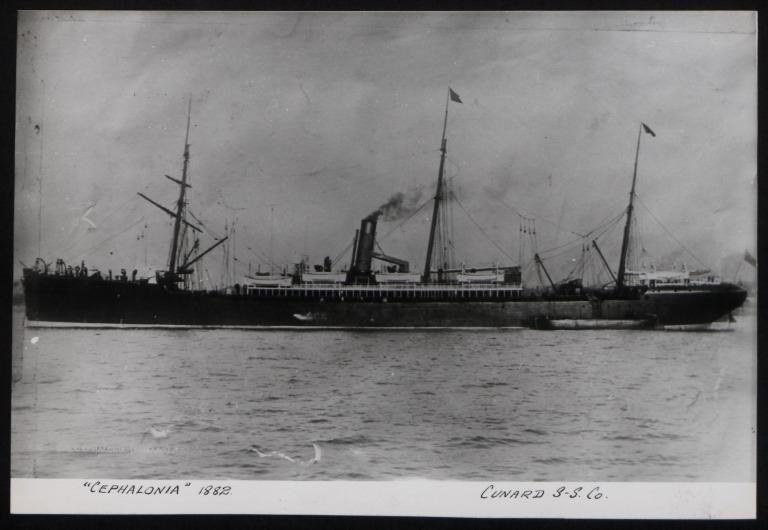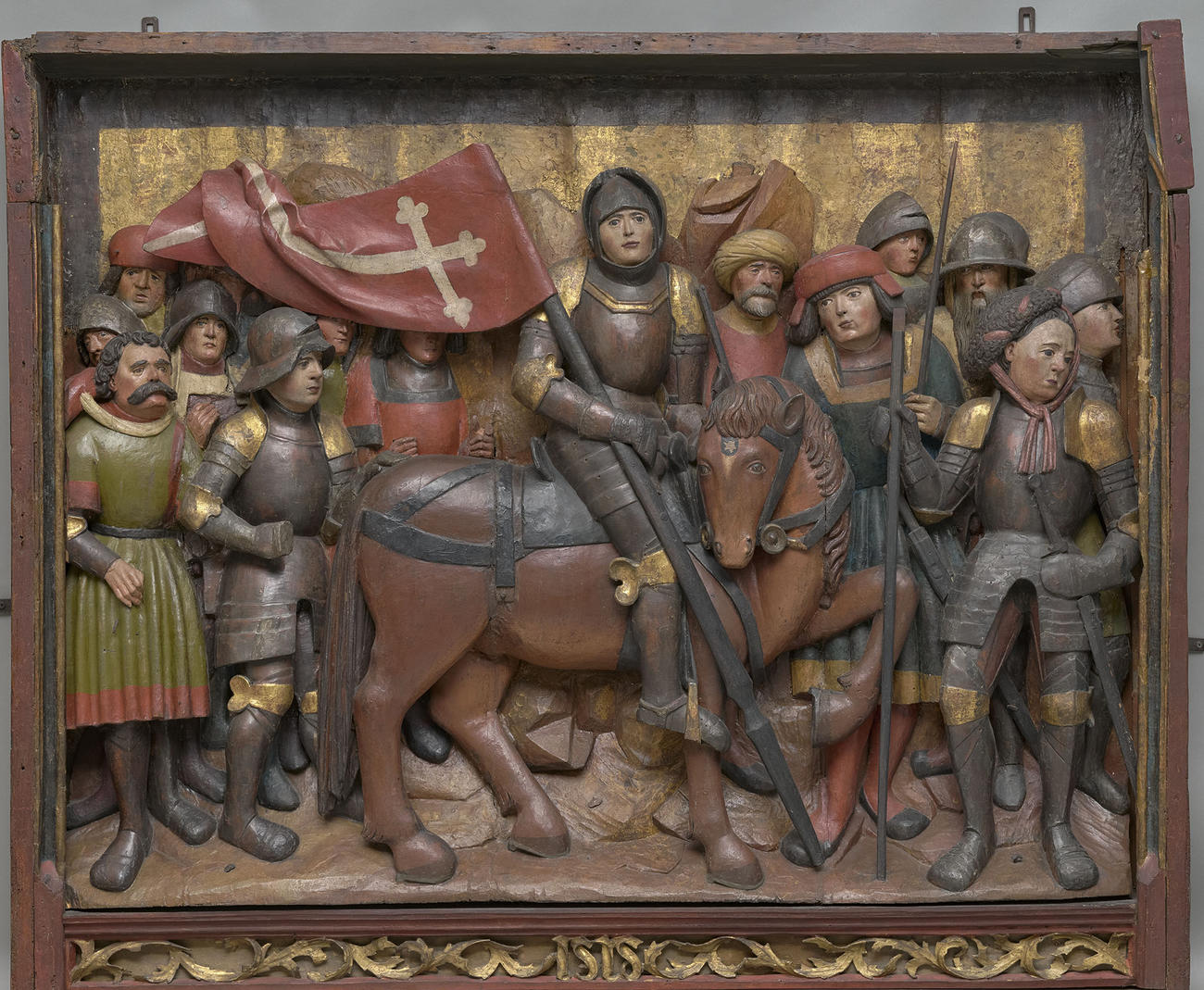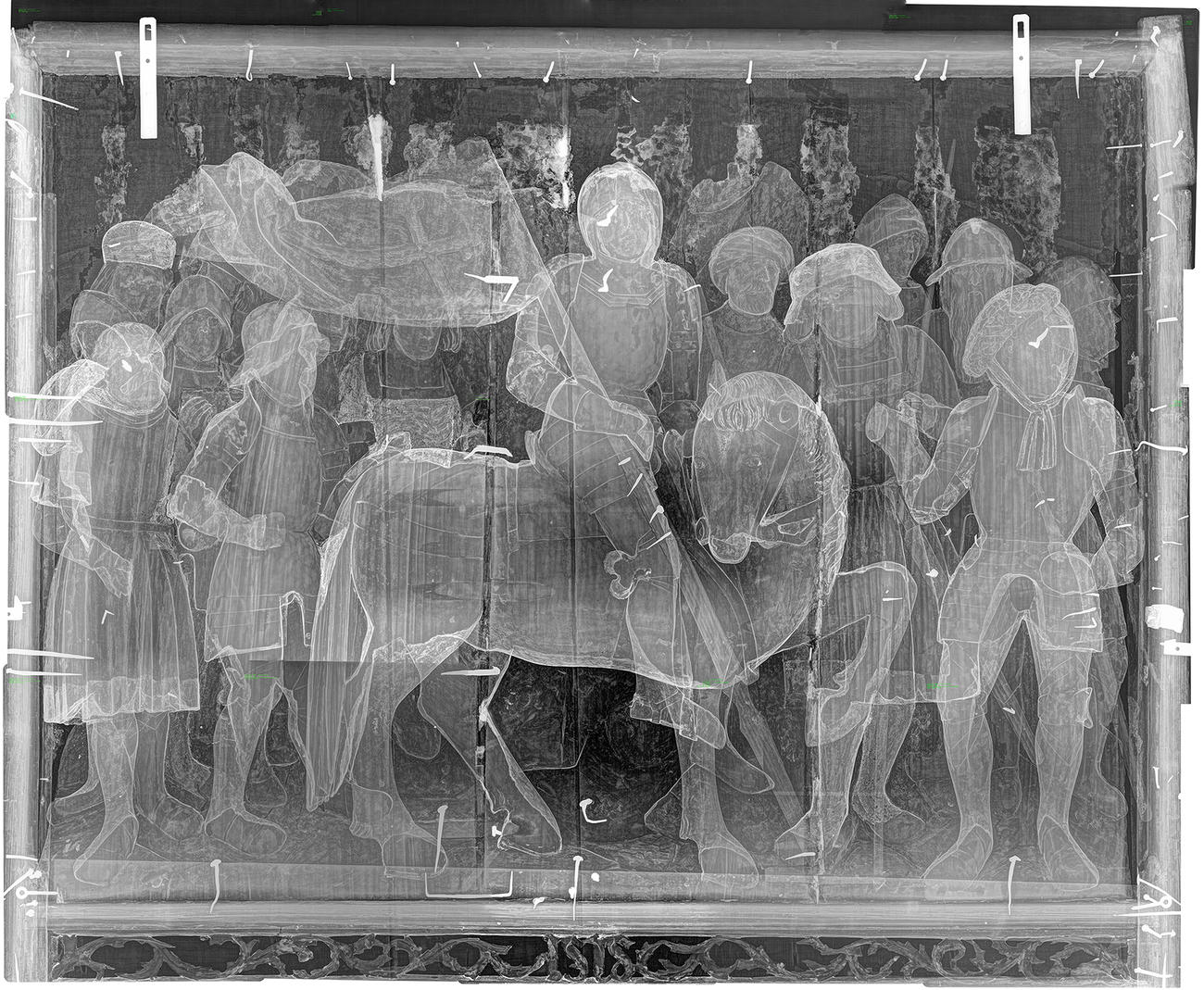Isabella Stewart Gardner purchased the Altar of Saint Maurice and the Theban Legion, a German or Swiss polychrome wood sculpture, on 9 May 1892 from the Parisian dealer and exporter Charles H. Rafard for 2,500 francs (almost $14,000 in today’s dollars). The dealer sent the sculpture across the Atlantic Ocean in January of 1893 on the steamer Cephalonia along with Johannes Vermeer’s The Concert, a painting that was stolen from the Gardner Museum almost 100 years later in the 1990 theft.
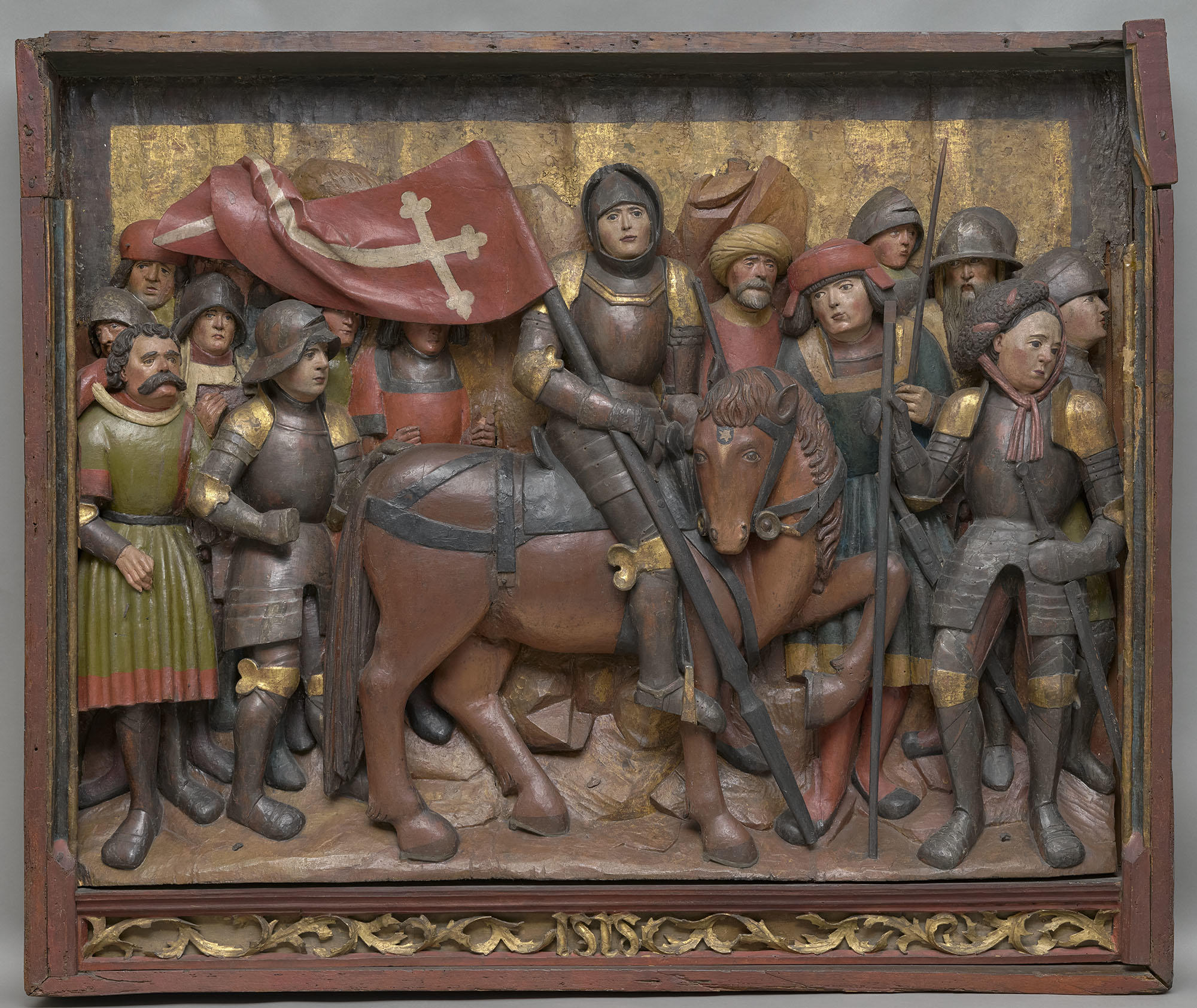
Isabella Stewart Gardner Museum, Boston (S30e12). See it in the Gothic Room.
German, Upper Rhenish or Swiss, Altar of Saint Maurice and the Theban Legion, about 1515. Polychromed poplar, 131 x 152.5 cm (51 9/16 x 60 1/16 in.)
Today, the sculpture hangs above a fireplace in the Gothic Room, on the third floor of the Isabella Stewart Gardner Museum. The carving shows a group of sixteen warriors in armor surrounding a figure on horseback at the center. The central figure holds a red banner inscribed with a white cross. It is likely that the sculpture was the lower left panel of a much larger altarpiece made for a church because of anchoring hardware found along the top and right of the sculpture’s frame.
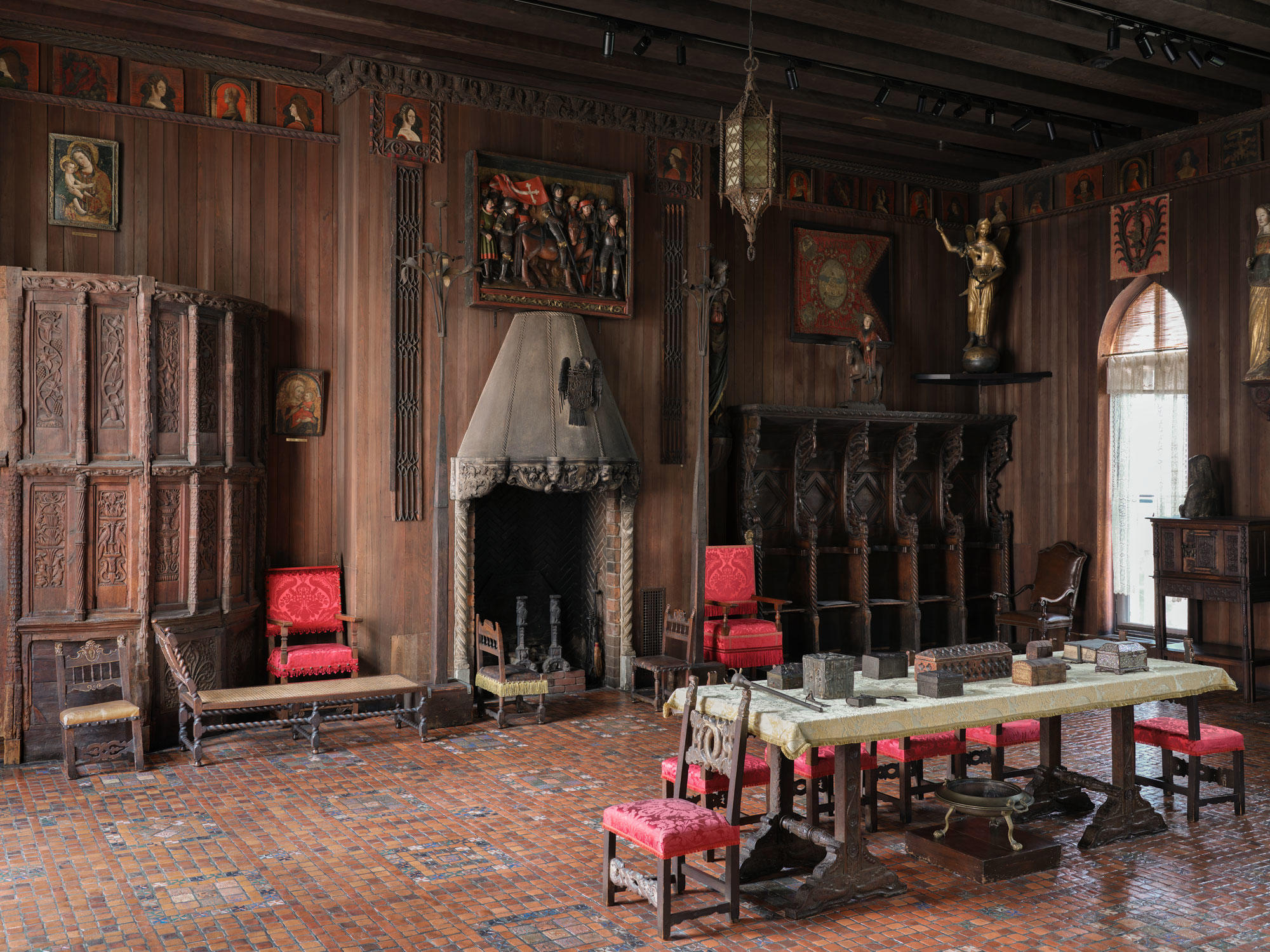
Isabella Stewart Gardner Museum, Boston
The Gothic Room, showing the Altarpiece of Saint Maurice and the Theban Legion
When Isabella acquired the sculpture, Saint Maurice was identified as Joan of Arc and over several decades the horse-mounted figure was assigned multiple saintly identities. The mystery around the figure's true identity highlights the difficulty modern researchers face when objects are altered or removed from their original setting. Certain visual customs of Christian art have been forgotten or lost, and we can no longer identify the identities of the characters we see.
Identifying the Saint in the Sculpture
Relying on different visual clues in the sculpture, scholars identified the central figure as Joan of Arc until the authors of the 1935 General Catalogue listed it as Saint George and the Fourteen Holy Helpers or possibly Saint Gereon and the Theban Legion. Museum curators eventually dismissed the Saint George and Holy Helpers identification because the number and types of figures in the altarpiece do not correspond to conventional depictions of the Holy Helpers.
A 1972 publication on German sculpture in New England listed the central figure of the altarpiece as Saint Gereon or Saint Maurice and the Theban Legion. These two saints have very similar hagiographies with equally similar iconographies, making it difficult to differentiate between the two. Maurice was a high-ranking officer in the Roman army in the third century from Thebes, Egypt who commanded a legion composed entirely of Christians. He and his soldiers were martyred when they refused the Emperor’s order to persecute Christians during a campaign, an act which would be tantamount to renouncing Christianity.
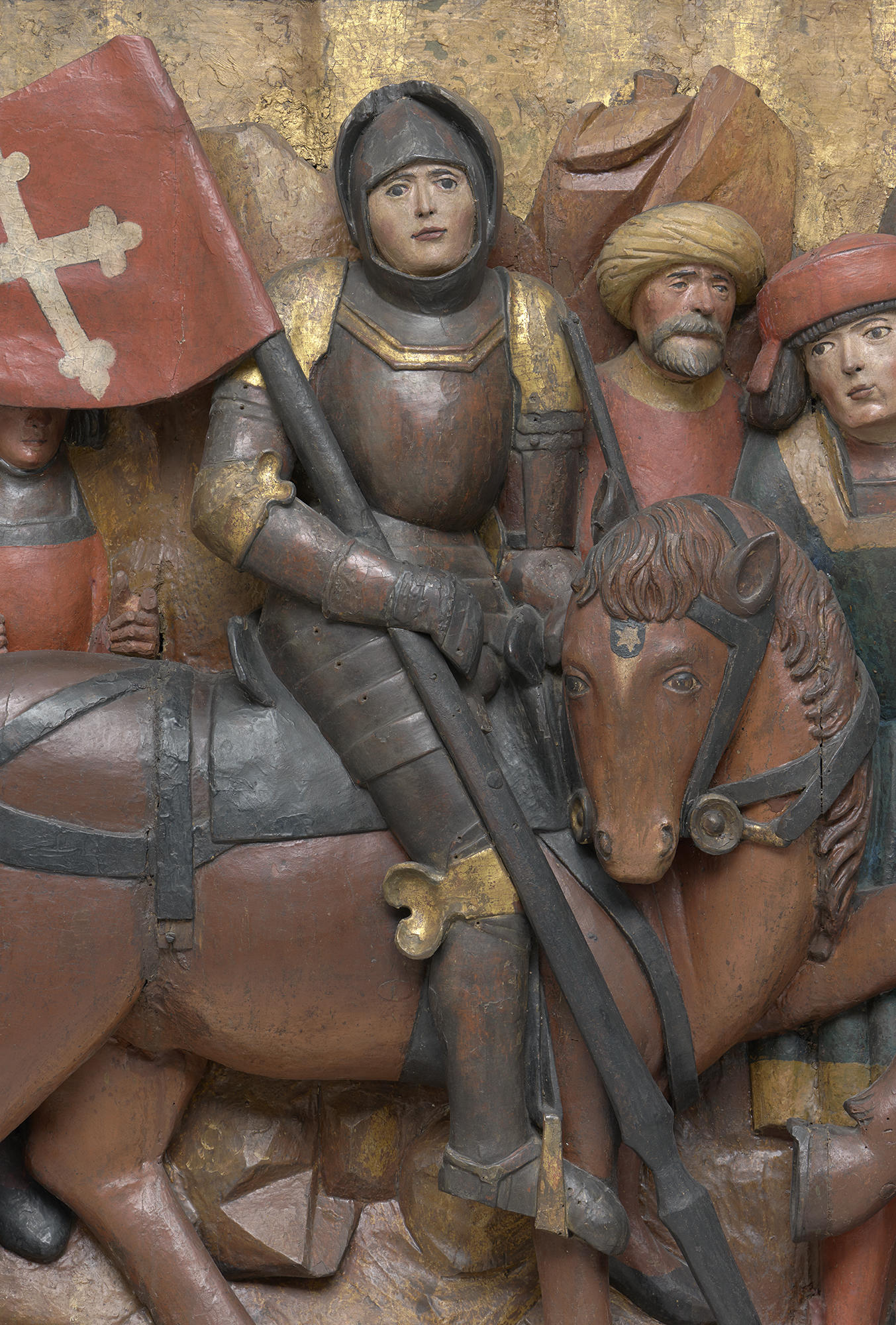
Isabella Stewart Gardner Museum, Boston (S30e12)
Detail of the Altar of Saint Maurice and the Theban Legion, showing the central figure
Maurice’s story of martyrdom lent itself to the aspirations of Christian rulers who used Saint Maurice to epitomize the perfect Christian soldier who defended the faith while also obeying their leaders. For example, the Holy Roman Emperor Otto I (912–973) adopted Maurice as the empire’s patron saint, and Maurice became the patron saint of soldiers. Saint Maurice is also interesting because he is one of the few saints repeatedly depicted in European art as a man with intentionally dark skin. One of the most well known depictions of Saint Maurice is a thirteenth century sandstone sculpture from the Magdeburg Cathedral in present day Germany that shows the saint as a dark skinned man.

The Image of the Black in Western Art Research Project and Photo Archive, W.E.B. Du Bois Institute for African and African American Research, Harvard University
German, St. Maurice, about 1240–1250. Cathedral of Saints Maurice and Catherine in Magdeburg, Germany
Around the year 500, town leaders in Cologne, Germany replaced Saint Maurice in the legend with Saint Gereon, a Roman soldier of the Theban Legion who was martyred in Cologne, in order to create a more local connection and have their own “bespoke” saint. Saint Gereon and Maurice therefore are depicted with similar iconography, but the Saint Gereon identification might have been changed since it is unclear whether the altarpiece is from Cologne.
Conservation Treatment and Scientific Analysis
In the summer of 2023, the sculpture was taken to the conservation lab for close visual and technical analysis. After closely examining the sculpture’s method of fabrication and previous restorations, the conservation team employed ultraviolet imaging, infrared imaging, x-ray fluorescence (XRF) spectroscopy, cross-section analysis, wood analysis, and x-radiography to determine and describe the materials present. For example, XRF spectroscopy, which provides elemental information on the surface layers, gave clarity on questions regarding the historical palette, restoration materials, and presence of metal leaf. The main elements present in the work are lead, mercury, calcium, and copper, which are expected in a historical color palette from the early 1500s. The panel and armor contain gold leaf or silver leaf over a bole layer on a calcium carbonate ground, so a lot of precious material was used to make this work. Given its scale and the materials used, the altar must have been important to the people who commissioned it.

Isabella Stewart Gardner Museum, Boston
Katherine Peters, Summer Graduate Intern in Conservation and Jess Chloros, Associate Objects Conservator carrying out x-ray fluorescence (XRF) spectroscopy on the Altar of Saint Maurice and the Theban Legion, 2023
XRF spectroscopy also pointed to selective placement of silver below the present painted surface layer telling us that the flag’s banner does not have its original iconography. Knowing the original design could impact the identification of the saint. In September of 2023, an x-ray scan of the sculpture was conducted at the Museum of Fine Arts, Boston with a hope that seeing through the sculpture will yield more information than just looking at it. The flag’s original design was not visible in the x-radiograph, so the mystery remains until future technology can obtain the data of the banner’s design below the surface.
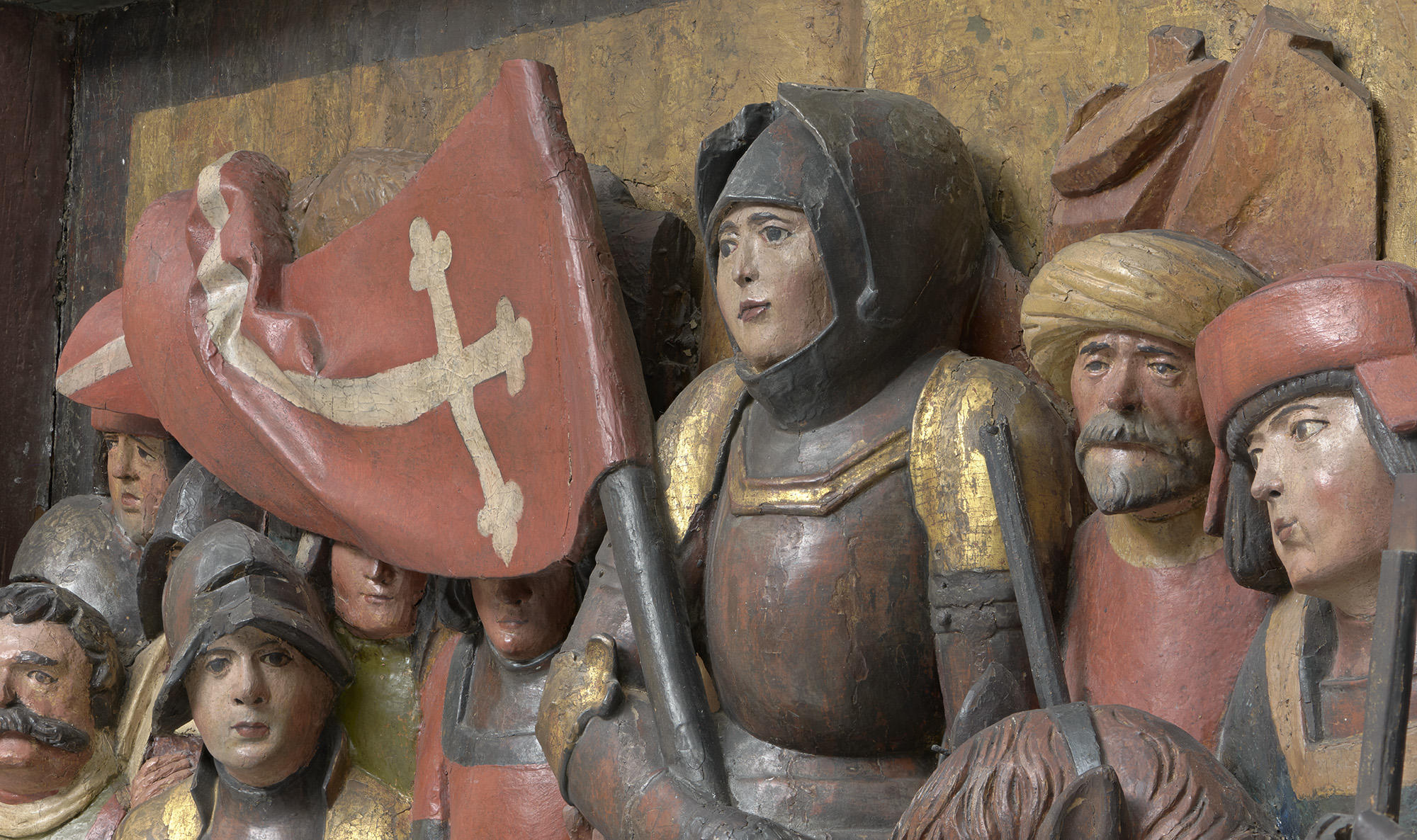
Isabella Stewart Gardner Museum, Boston (S30e12)
Detail of the Altar of Saint Maurice and the Theban Legion, showing the flag
Cross section analysis provided information on the paint layers as well as more precise elemental information about each layer. They were examined with a microscope in the conservation lab, and then analyzed using scanning electron microscopy and energy dispersive x-ray spectroscopy (SEM-EDS) by Richard Newman, Head of Scientific Research at the Museum of Fine Arts, Boston. This analysis indicated that the central figure on this altar only shows evidence of a white flesh tone. If the Museum’s sculpture had also shown a figure with dark skin tone, then the identity as Maurice would have been more definitive.
X-ray imaging taken at the Museum of Fine Arts, Boston
Altar of Saint Maurice and the Theban Legion and its X-Ray
Due to the collaborative work of the Gardner’s Conservation and Collections departments, Museum curators agree that the altarpiece figures are most safely identified as Saint Maurice and the Theban Legion.
You May Also Like

Read More on the Blog
Saint Christopher: World’s Best Travel Companion

Read More on the Blog
Anna Hyatt Huntington’s Joan of Arc Memorial

Read More on the Blog
Revealing the Layers of European Painted Wood Sculptures Using XRF Technology
![A receipt where the second line reads in French, Retable bois Gothique, Jeanne d'Arc [Gothic wooden altarpiece, Joan of Arc] 2500](https://www.gardnermuseum.org/sites/default/files/styles/portrait_large/public/2024-05/DF196_004.jpg)
![A receipt where first line reads in French, Rétable, bois sculpté du xv siècle [wooden altarpiece from the 15th century] and lines 8 and 9 read in French, Tableau Le Concert par Jean Van Der Meer, du xv century [painting The Concert by Johannes Vermeer from the 15th century].](https://www.gardnermuseum.org/sites/default/files/styles/portrait_large/public/2024-05/DF196_008.jpg)
